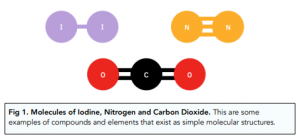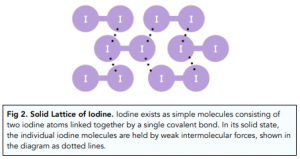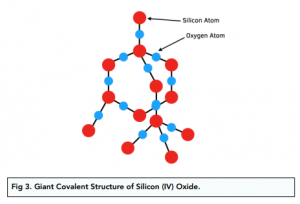Bonding - Properties of Covalent Structures (A-Level Chemistry)
Properties of Covalent Structures
Covalent Compounds
Covalent compounds form as result of pairs of electrons being shared between non-metal atoms.
Depending on the extent of covalent bonding in a compound, this can take two different structures: either simple molecular or giant covalent (or macromolecular) structures.
Simple Molecular Structures
A simple molecule consists of a group of relatively few atoms joined together by strong covalent bonds.
Both elements (such as iodine or nitrogen) and compounds (such as water or ammonia) can exist as simple molecules.

- Simple molecules are held together by weak intermolecular forces. The atoms within a molecule are held together by strong covalent bonds but individual molecules are held together by weak intermolecular forces of attraction.
- Compounds with simple molecular structure have low melting and boiling points. When in its solid state, the simple molecules that make up the compound are arranged in a regular lattice held together by weak intermolecular forces. As these interactions are very weak, not much energy is required to overcome them, which results in simple molecular structures usually being gaseous or liquid at room temperature.

- Covalent compounds cannot conduct electricity. This is because there are no mobile ions or electrons to carry the current.
Giant Covalent Structures
- A giant covalent structure is where a large number of atoms are joined by covalent bonds. A giant covalent structure involves lots of covalent bonds present between several atoms which forms a giant lattice. As lots of covalent bonds are present in the compound, the structure is extremely strong.

- Compounds with giant covalent structure have high melting and boiling points. The large number of strong covalent bonds involved means that large amount of energy is required to break them apart.
- Covalent compounds cannot conduct electricity. This is because there are no mobile ions or electrons to carry the current.
Bonding in A-Level Chemistry refers to the process of forming chemical bonds between atoms to create molecules or compounds. There are different types of bonds, including covalent bonds, which are the focus of this topic.
Covalent bonds are chemical bonds formed between two atoms when they share electrons. This results in a strong bond between the atoms, creating a stable molecule.
The properties of covalent structures include:
They are generally stable and do not easily break apart
They are typically solids with low melting and boiling points
They are poor conductors of electricity
They are typically non-polar, meaning they do not have a positive or negative charge.
It is important to study the properties of covalent structures in A-Level Chemistry because these properties determine the way that the molecules behave in different chemical reactions. Understanding the properties of covalent structures also helps to predict how they will interact with other substances and how they will react in different conditions.
Covalent bonds affect the physical properties of a substance because they hold the atoms together in a stable structure. This stability results in the substance having a low melting and boiling point, being a solid at room temperature, and being a poor conductor of electricity.
Covalent bonds affect the reactivity of a substance because they hold the atoms together in a strong bond. This means that the substance is typically less reactive than substances with weaker bonds, as it requires more energy to break the covalent bonds and initiate a reaction.
Polar covalent bonds are covalent bonds between atoms with different electronegativities, resulting in a molecule with a positive and negative end. Non-polar covalent bonds are covalent bonds between atoms with similar electronegativities, resulting in a molecule with no positive or negative charge. The difference between polar and non-polar covalent bonds affects the way that the molecule interacts with other substances and how it behaves in different chemical reactions.





Still got a question? Leave a comment
Leave a comment